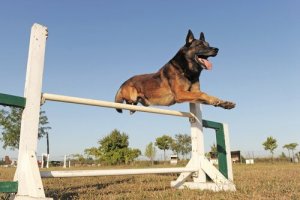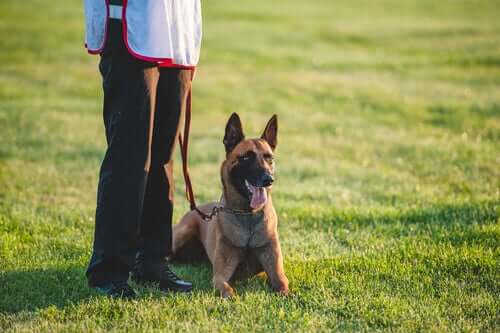Professional Training for the Belgian Shepherd

The Belgian Shepherd is a highly valued breed because they’re easy to train and are great at carrying out emergency or police work. Their close resemblance to the German Shepherd, among other things, has helped make them instantly recognizable. But what’s involved in professional training for the Belgian shepherd? Find out in today’s article!
Because of their large size, these dogs could easily become domineering animals without proper training or socialization. This means that training has to be an essential part of their routine from a young age.
One of the best training options for this type of dog is known as ‘K9’, or more commonly police dog training. Obviously, the term ‘K9’ comes from the word ‘canine’.
So, without further delay, let’s take a look at what this type of training involves. It’s fascinating!
Professional training for the Belgian Shepherd
This training teaches the dog to carry out different police tasks such as defending and protecting people, searching for drugs, identification at fire scenes, and rescuing people. However, it’s really important that they don’t become “a jack of all trades and master of none”. These dogs are trained to carry out only two of these tasks at most.

Obviously, these tasks can only be taught in specialized centers or with an accredited professional trainer. The Belgian shepherd is an excellent dog for this type of training because of their courage, temperament, intelligence, and character. In fact, they currently appear to be replacing the German Shepherd.
Training takes between 12 and 16 weeks and is carried out either at a specialized center or under the instructions and supervision of a private trainer.
What does this training achieve?
The aim is to ensure that the dog that has been trained or has become a ‘K9’. This will ensure that they’re able to ignore their surroundings and focus on their work.

They’re expected to show respect towards other animals and people and, obviously, they need to obey their owner at all times. They need to have the self-restraint to control their impulses, strength, and instincts, keeping their behavior well-balanced.
In order to carry out the tasks that they’ve been trained for, these dogs need to obediently respond to verbal commands and gestures. They need to become experts at searching for drugs and explosives, as well as coping with pressure in search and rescue situations. And, obviously, at a basic level, they need good reflexes when defending themselves or attacking a target.
All of this means that the training is quite difficult. In fact, although positive reinforcement is involved, the training method employs a mix of techniques to ensure that the dog understands who is in charge and follows instructions strictly.
Of course, this doesn’t mean that the animal suffers any harm. Trainers aim to achieve their objectives whilst always caring for the animal and treating them with the utmost respect, although with some firmness.
Do you want a K9?
All of this might have pricked your interest and made you think about getting one! Well, as it happens, once police dogs get to eight years old, they usually retire and can be adopted.
It’s not that they’re no longer useful. It’s more the case that this way they can have a calm, quality life in their remaining years. There are many special programs that exist where you can find these dogs.
It’s also an excellent way to help security forces and organizations because there aren’t always enough workers who can keep them when they retire. And, as for you, well, you’ll have an excellent animal at home who’s loyal and perfectly trained. What more could you want?
The Belgian Shepherd is a highly valued breed because they’re easy to train and are great at carrying out emergency or police work. Their close resemblance to the German Shepherd, among other things, has helped make them instantly recognizable. But what’s involved in professional training for the Belgian shepherd? Find out in today’s article!
Because of their large size, these dogs could easily become domineering animals without proper training or socialization. This means that training has to be an essential part of their routine from a young age.
One of the best training options for this type of dog is known as ‘K9’, or more commonly police dog training. Obviously, the term ‘K9’ comes from the word ‘canine’.
So, without further delay, let’s take a look at what this type of training involves. It’s fascinating!
Professional training for the Belgian Shepherd
This training teaches the dog to carry out different police tasks such as defending and protecting people, searching for drugs, identification at fire scenes, and rescuing people. However, it’s really important that they don’t become “a jack of all trades and master of none”. These dogs are trained to carry out only two of these tasks at most.

Obviously, these tasks can only be taught in specialized centers or with an accredited professional trainer. The Belgian shepherd is an excellent dog for this type of training because of their courage, temperament, intelligence, and character. In fact, they currently appear to be replacing the German Shepherd.
Training takes between 12 and 16 weeks and is carried out either at a specialized center or under the instructions and supervision of a private trainer.
What does this training achieve?
The aim is to ensure that the dog that has been trained or has become a ‘K9’. This will ensure that they’re able to ignore their surroundings and focus on their work.

They’re expected to show respect towards other animals and people and, obviously, they need to obey their owner at all times. They need to have the self-restraint to control their impulses, strength, and instincts, keeping their behavior well-balanced.
In order to carry out the tasks that they’ve been trained for, these dogs need to obediently respond to verbal commands and gestures. They need to become experts at searching for drugs and explosives, as well as coping with pressure in search and rescue situations. And, obviously, at a basic level, they need good reflexes when defending themselves or attacking a target.
All of this means that the training is quite difficult. In fact, although positive reinforcement is involved, the training method employs a mix of techniques to ensure that the dog understands who is in charge and follows instructions strictly.
Of course, this doesn’t mean that the animal suffers any harm. Trainers aim to achieve their objectives whilst always caring for the animal and treating them with the utmost respect, although with some firmness.
Do you want a K9?
All of this might have pricked your interest and made you think about getting one! Well, as it happens, once police dogs get to eight years old, they usually retire and can be adopted.
It’s not that they’re no longer useful. It’s more the case that this way they can have a calm, quality life in their remaining years. There are many special programs that exist where you can find these dogs.
It’s also an excellent way to help security forces and organizations because there aren’t always enough workers who can keep them when they retire. And, as for you, well, you’ll have an excellent animal at home who’s loyal and perfectly trained. What more could you want?
This text is provided for informational purposes only and does not replace consultation with a professional. If in doubt, consult your specialist.








